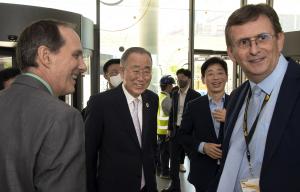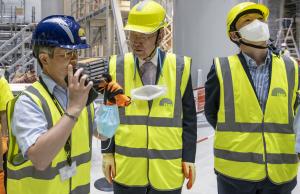Distinguished visitors from Korea
Participants to the Europe-Korea Conference on Science and Technology (EKC) in Marseille took an afternoon off, last week, to pay a visit to the ITER site. The 120-person-strong group was headed by Korea's Vice-Minister of Science and ICT, Tae-Seog Oh, accompanied by former Secretary-General of the United Nations (2007-2016) Ban Ki Moon, now Chairman of the Foundation for a Better Future.
Whereas Vice-Minister Oh receives regular reports on ITER, former Secretary-General Ban was new to the project's progress and challenges. As Kijung Jung, the head of the Korean Domestic Agency, guided the group through site landmarks such as the Poloidal Field Coils Winding Facility, the Assembly Hall, and the tokamak pit, Ban discovered something that was familiar to him: nations working together for a common goal. The ITER collaboration, which brings together 35 nations, is smaller than the United Nations, which comprises 193 Member States. "But what I sense here is a similar spirit," said the former Secretary-General.
Standing at the foot of the giant, Korean-built sector sub-assembly tools where ITER vacuum vessel sector "modules" are assembled, both men felt an intense pride for their country. "Of course there are issues, delays and unpredictable challenges," said Vice-Minister Oh. "This is inevitable with such a complex, multinational, one-of-a-kind venture."
Korea—which passed a "Fusion Energy Development Act" as early as 2006—is determined, in the Vice-Minister's words, "to make it happen and find ways to speed up its availability." As for Ban Ki Moon, whose most significant contribution during his tenure as the 8th Secretary-General of the United Nations was the adoption of the 2015 Sustainable Development Goals and the Paris Agreement on Climate Change, he sees in ITER and fusion a key element in the global fight against climate change. "I believe in the power of science," he said at the close of the visit, asking Kijung Jung to provide him with more information, documents and illustrations for a deeper understanding of the promise of ITER—this "most ambitious project" for the future of humankind.



